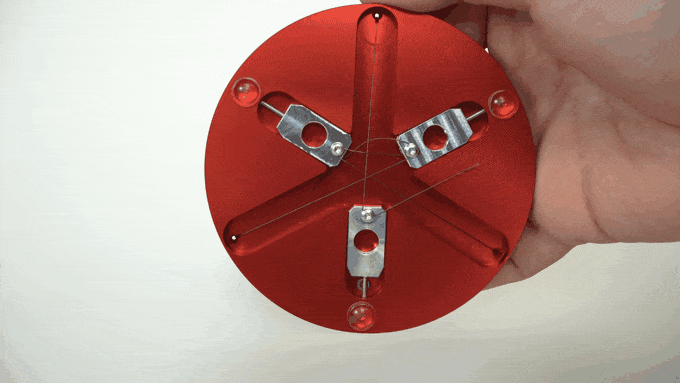|
|
We've replaced the central cable on our standard tensegrity table with magnets! So now you have
magnets with a visible air gap and thin wires keeping it up!
Normal tables need to have reasonably strong legs in order to be able to hold the table top as well as any items you place on it, and the legs need to be secure and rigid enough to stop the table wobbling. Tensegrity tables are visually and mechanically quite different. The table top almost appears to float in mid air, with unbelievably thin wires going down to the base structure. At first glance it appears almost impossible... and most people don't find the mechanics of how it works intuitive. So how does it work?The magnets are under attraction, they are trying to pull together. This means the magnet attached to the top arm is trying to pull itself upwards towards the magnet hanging from the bottom arm. Because the top arm is firmly fixed to the top plate any upwards force from the top arm is also exerted on the top plate. The three wires around the outside of the table are under tension and held taut, their length prevents the two magnets from ever touching each other and thus the table is held together under tensional integrity. Because the top plates are not rigidly connected to the bottom plates the tables will give a little jiggle when nudged. The image immediately below shows the new magnet table, the image below that shows the original conventionally wired table. 
Precision engineeredThis Tensegrity table is precision engineered. What do we mean by that? There's no glue. No cheap nasty components. Everything has been designed and prototyped by us, for production in our factory in Maidenhead, England. We take take pride in what we do, we control the quality and we make things to last. The solid, crisp machined anodised aluminium provides a nice contrast to the thin wires and air gap. 
StrengthWith a 2mm gap between the magnets the table can hold up to 260g before the magnets pull apart. You can adjust the distance of the magnets by tensioning the outer cables, having them closer together allows the table to hold more weight, further apart makes it visually more impressive. Here the table is supporting one of our Stirling engines. 
Fully adjustable cable tension for perfect balance Hidden underneath the base of the table is a fully adjustable mechanism to allow each of the outer cables to be adjusted for length and tension. This allows you to get the table perfectly level and to have a smaller or larger gap size between the magnets. 
Supplied in kit formThe tables will be supplied in kit form in a custom foam insert which we have designed and manufactured ourselves. This ensures that all the parts are safe and secure while in transit. The box is small enough to fit through most letterboxes. The kit contains everything you need for assembly, including a T6 torx driver and 3D printed assembly jig. The assembly jig holds the arms and plates securely in position while the cables and magnets are attached. 
HistoryTensegrity is a contraction of tensional integrity, a phrase that was coined by Buckminster Fuller. Tensegrity structures are sometimes known as floating compression structures. To find out more information about Buckminster Fuller and tensegrity structures visit this wiki page. |






-100.webp)
-180.webp)